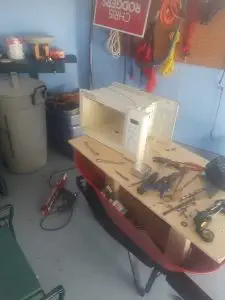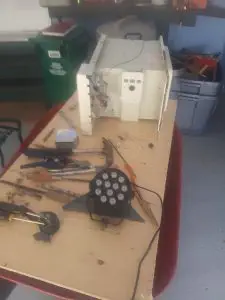Dr. Art Hunter, CACOR Board of Directors, explains the construction of a Covid-19 decontamination chamber.
Far-UVC Light Safely Kills 99.9% of Airborne Coronaviruses
“More than 99.9% of seasonal coronaviruses present in airborne droplets were killed when exposed to a particular wavelength of ultraviolet light that is safe to use around humans
Conventional germicidal UVC light (254 nm wavelength) can be used to disinfect unoccupied spaces such as empty hospital rooms or empty subway cars, but direct exposure to these conventional UV lamps is not possible in occupied public spaces, as this could be a health hazard.”
The literature is very clear, 254 nm radiation in the right dosage can kill all living bacteria, viruses, and human cells. It is a blessing and a threat. Safety is a top priority design requirement in the development of this hobby made chamber.
In early June 2020 a used but functional microwave oven was purchased for $15 and sat in the garage for 3 weeks to decontaminate. Time is an excellent decontamination method as the SARS-CoV-2 virus has about a 1.1 hour half-life outside of the human body. However, often small objects need to be disinfected from surfaces in time periods very much less than weeks. Hence the need for a disinfection chamber that will take only seconds or minutes to achieve the same or smaller reduced viral load.

This figure shows the garage work table (in a wheelbarrow) with the microwave oven mostly stripped down to the case. The intent was to build a decontamination chamber the size of a microwave oven and use the door interlock switch and possibly the timer and other electronics that survived the teardown. The large high voltage transformer was removed as were all the parts to make microwaves. The turntable, light bulb, ventilation fan and other non-essential parts were removed leaving only the case with the control panel and the printed circuit board mainly undisturbed. The top surface of the chamber has been lined with aluminum foil at his stage of the build. The other 5 surfaces will be also covered in highly reflective Al foil as the intent is to build a very imperfect (not smooth reflective surface) chamber of mirrors so the generated UVC radiation will reflect in multiple angles. The intent is to encourage UVC to penetrate into tiny crevices around cellular telephone push buttons and other hard to clean slots on any complex shaped object.

The intent of this photograph is to show the UVC lamp with its twelve 254 nm LEDs, so the viewer gets the sense of size and the expected impressive UVC output power. It is described as “36W Portable Disinfection UV Germicidal Lamp Ozone Sterilization Light — Medical Stage Lamp UV Sterilizer Lamp.” It looks really angry. This UVC Lamp is very dangerous as it will kill skin cells and cause blindness if improperly used. Hence the need for a closed chamber with an automatic door safety power switch. You can also see from this shot that there is nothing left in the electronics area other than the control panel and the board behind it. The tangle of wires is the cable harness that was used to power all the removed parts.
- The remaining tasks are to build a cardboard box test set to insert the UVC lamp, make appropriate settings and shine it on a mini-solar panel (4″ x 6″) to see if it will produce enough voltage to drive a small instrumentation panel LED light as it is necessary to know if the UVC LEDs are operational when the power is turned on. Since you can’t look at it (damage to the retina and UVC is too high a frequency for human sight) then the voltage output from the mini solar array will be the sensor that acknowledges that UVC is being applied to the target and a sense of the flux density.
2. Design and build the foil covering the five remaining surfaces. This is not trivial as they must be designed for maintenance and each has its own unique interface with the chamber surface. Mounting the mini-solar panel is part of this task. Further the door is a special case as it presently has a glass window that needs to be sealed inside and outside. It is intended to use the outside door surface to contain the required “caution and warning” labels and operating instructions.
3. The electronics needs to have its additional own 120 Volt input power toggle safety switch and an appropriately mounted red LED light indicating UVC is “on”. The cable harness needs tidying and everything tested to see what functionality remains in the microwave oven control panel. The only essential functionality is the door open power off interlock and the timer. Anything else is a bonus.
4. Build the wire rack that the target payload sits on so all 6 of its sides get exposure to UVC radiation. This is trivial but necessary.
5. Assemble the chamber so it will look like a microwave oven once again. Test and adjust as necessary.
6. Finally, relocate the chamber onto a wheeled platform that is table height (30″) so that it can be transported and moved to any place on the planet. I t is expected that this chamber will spend the rest of the summer and autumn in the garage where “foreigners” can “safe social distance” inspect and have their target devices decontaminated. The most use will be to decontaminate face masks and telephones but anything that fits in the chamber will get the same exposure. Some target decontamination objects include used books, pens, tools, computer mouse, credit cards, wallets, purse contents, money (coins and paper) and TV remotes.
Finally some advice from the International Ultraviolet Association Link to the IUVA
Part 2 of this development will be reported in the coming weeks.
Leave a Reply